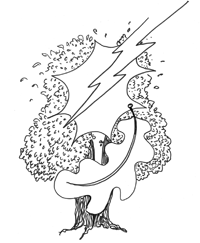STRANGEBUTTRUE- Oak trees: Why they explode in lighting strikes

Q. Folklore says lightning seeks out oak trees, and surprisingly a high percentage of trees shattered are oaks. So how does lightning pick them out from all the rest? –B. Franklin
A. Oaks aren't hit more, but their rough bark traps rainwater and keeps the lower trunk dry, especially early in a storm, says Jearl Walker in Flying Circus of Physics.
Smooth-barked trees get drenched faster, top to bottom, so the lightning descends harmlessly through the water sheath into the ground. For oaks, the current more often enters the tree, heats the sap and blows the trunk apart.
Q. What is "snarge,"and how are the good folks at the Smithsonian Institution's Feather Identification Laboratory working to make your next plane flight safer? –S. Sullenberger
A. Believe it or not, snarge is the bird goo left over from a collision with an airplane. And it's not just birds.
"We've had frogs, turtles, snakes, even a cat once struck at high altitudes," says the Smithsonian's Carla Dove. Birds like hawks and herons will occasionally drop their quarry into oncoming planes.
Recently, she sent a "snake" sample to the DNA lab and it came back as rabbit.
"How do you explain to the Federal Aviation Administration (FAA) that we had a rabbit strike at 1,000 feet?" Dove asks.
It's of intense interest to both the FAA and the U.S. military to know what kinds of birds are smacking into the nation's airplanes. At the lab, technicians identify the snarge DNA, then enter the sequence into a national database.
Although most cases consist of feathers, many consist of a "paper towel swipe" of gooey bird fat, flesh bits, spores. Once the type of bird is identified, steps can be taken to avert future incidents, such as by altering flight paths and by engineering more bird-resistant planes.
As an example, jet engines must now be able to withstand the ingestion of an eight-pound waterfowl. "Of course, we're trying to improve aviation safety," says Dove, "but we're also helping to save the birds."
Q. It's hard to sell the valiant human spirit short, especially when that spirit yearns to communicate under the most difficult of circumstances, such as the spirit of French journalist Jean-Dominique Bauby, who wrote the book The Diving Bell and the Butterfly, on which the movie was based. Explained one New York critic: The lightness of the butterfly symbolizes the persistence of Bauby's spirit, the heaviness of the bell his extreme physical difficulties. What difficulties? –S. Hawking
A. Bauby himself composed and dictated his memoir recounting the massive stroke that left him in a state known as "locked-in syndrome," mentally alert but deprived of speech and of all movement except for control of his left eyelid, says William Hanson in The Edge of Medicine.
Bauby painstakingly "wrote" by blinking his eyelid to select each letter as an assistant ran through a frequency ordered alphabet and came to the correct letter.
He dictated the slim volume in the summer of 1996, averaging only a single word every two minutes. The following spring, ten days after the highly successful publication of his book, Bauby died.
~
Send Strange questions to brothers Bill and Rich at [email protected].
#